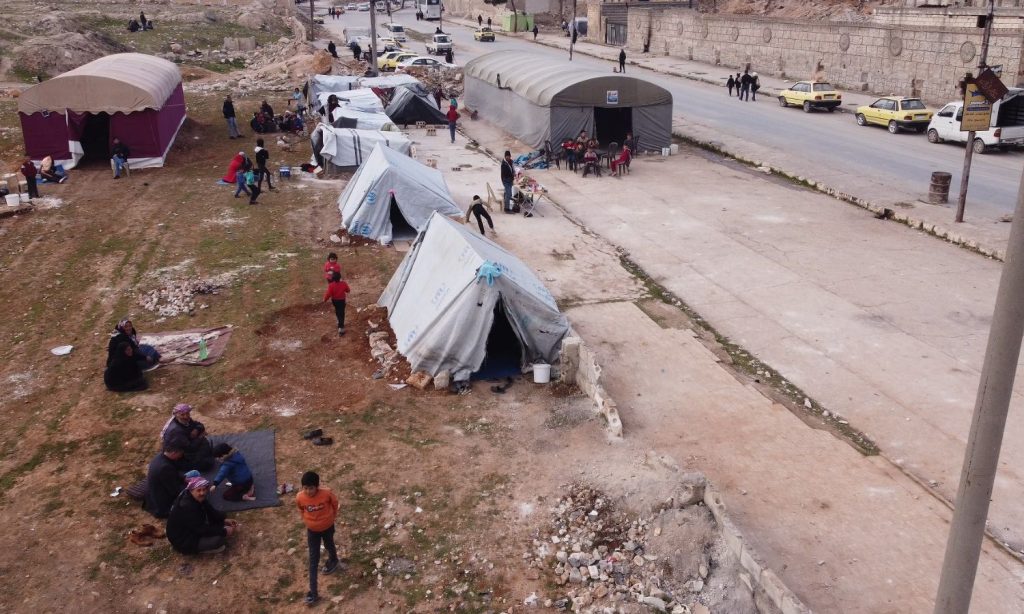Enab Baladi – Aleppo
The siege imposed on Sheikh Maqsoud and Ashrafieh neighborhoods in the northern city of Aleppo by the Syrian regime continued, despite the Feb.6 earthquake that hit the region, which increased the suffering of the afflicted people.
Six people in the two predominantly Kurdish neighborhoods lost their lives as a result of the earthquake, in addition to the occurrence of about 100 severe and moderate injuries and cases of nervous breakdown, according to the General Council of Sheikh Maqsoud and Ashrafieh neighborhoods, affiliated to the Autonomous Administration of North and East Syria (AANES).
Five buildings collapsed in the two neighborhoods, and 12 others need to be removed, due to the great damage incurred after the earthquake, in addition to 400 buildings damaged.
About 50,000 people were forced to internally flee from buildings to ground houses, in addition to 10,000 others heading to tents and temporary shelters, and about 3000 families from the two neighborhoods were displaced to the al-Shahba area, north of Aleppo.
The report of the General Council of the two neighborhoods included the needs of the afflicted people in terms of food and sanitary baskets and blankets sufficient for 50,000 people, while the Civil Defense rescue agency needs heavy machinery to remove buildings that are threatened with collapse.
Siege subject to agreements
The siege of Sheikh Maqsoud and Ashrafieh by the elite Fourth Division forces was not new to the two neighborhoods, as the continuous siege increased the population’s need, even before the earthquake, for basic foodstuffs, medicine, infant formula, and fuel, which were entered through mutual agreements between the Autonomous Administration and the Syrian regime.
Mustafa, 51, who refused to give his full name for security reasons, from the Ashrafieh neighborhood, told Enab Baladi, “The earthquake destroyed the house, and we no longer have anything in the midst of the siege imposed on us by the (Fourth Division).”
Mustafa complained about the lack of aid entering the neighborhood, compared to the volume of aid coming to the areas controlled by the regime, as if “the Ashrafieh neighborhood comes from outside the affected neighborhoods of Aleppo,” according to him.
Mustafa is forced to go outside the neighborhood to buy his basic needs and pay “exhausting” transportation costs, despite his deteriorating economic situation after the earthquake.
Since the first days of the earthquake, the Autonomous Administration has tried to send aid to the afflicted in the neighborhoods of Sheikh Maqsoud, Ashrafieh, and al-Shahba, while the regime did not allow the entry of aid through the crossings separating the two parties, except for fuel tankers, 60% of which were seized.
The co-chair of the Social Affairs and Labor Authority in the Autonomous Administration, Maryam al-Ibrah, said, on February 26, that “(the Autonomous Administration) took the initiative, from the first hours of the earthquake disaster, to provide aid to the stricken areas, while the Damascus government closed the doors and crossings to this aid.”
She added, “The Damascus government only received fuel, and there was a price for bringing it in, which is taking two-thirds of the amount sent to the besieged areas affected by the earthquake.”
On February 20, that is, two weeks after the disaster, the first UN aid convoy consisting of nine trucks carrying humanitarian aid and shelter supplies entered the two neighborhoods, and on the 22nd of the same month, another UN aid convoy entered, consisting of five trucks containing tents and blankets.
The aid sent by the Autonomous Administration and the Kurdish Red Crescent continues, awaiting the approval of the regime to enter and provide relief to the afflicted.
Tents set up by residents of Sheikh Maqsoud neighborhood, northeast of Aleppo, for those affected by the earthquake – March 4, 2023 (Hawar News Agency)
International condemnation
Nevin, a pseudonym for security reasons, a young Kurdish woman from Sheikh Maqsoud neighborhood, told Enab Baladi that the neighborhood was not among the interests of the regime government before or after the earthquake.
No official from the regime’s government visited the neighborhood after or before the earthquake, when a residential building collapsed, killing ten people on January 22, Nevin confirmed.
Regarding the situation of services in the neighborhood after the earthquake, Nevin explained that the siege did not leave room for an improvement in conditions, as the earthquake led to the displacement of many families who sought shelter with their relatives or in shelters and food aid was distributed to those affected by the General Council of the two neighborhoods.
After the entry of fuel tankers, the hours of electrical feeding from the generators scattered in the neighborhood increased to three hours instead of two hours, according to Nevin.
On March 6, Amnesty International published a report in which it said that within a month after the disaster occurred, the regime had prevented at least 100 trucks carrying basic aid such as food, medical supplies, and tents from entering predominantly Kurdish neighborhoods in the city of Aleppo.
Since August 2022, the regime has imposed a “brutal siege” on these two neighborhoods, preventing fuel, food, medical supplies, and other essential aid from reaching the tens of thousands of civilians who live there, according to the report.
These neighborhoods completely depleted their pre-earthquake medical supplies, making them ill-equipped to deal with earthquake-related injuries.
Syrians for Truth and Justice (STJ) documented, in its report published on February 21, that the Syrian authorities prevented aid convoys from entering their areas of influence through the “al-Tayha” crossing.
The human rights group said in its report that, based on the provisions of international law, the Syrian authorities are to secure the humanitarian needs of all the civilian population on their territory, and since these authorities do not exercise effective authority over some regions, they must allow the passage of humanitarian aid without conditions or complications.

